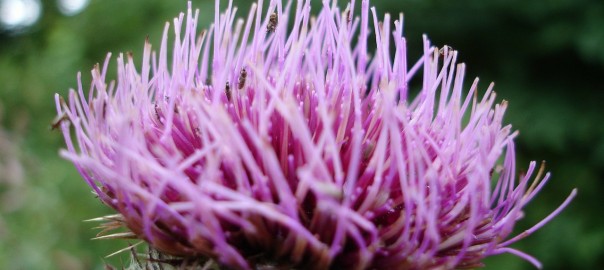[Excerpt from my free eBook, “Ten Wild Herbs For Ten Modern Problems”]
Milk Thistle For Toxic Overload
Do you remember those thorny, bristly flowers that Eeyore was always eating in Winnie the Pooh stories? The same purple plant that graces the cover of this book and was enjoyed as a meal by a melancholy donkey is the exact herb you want for optimal liver health.
The liver is our detoxification center. It filters the blood while removing toxins and metabolizing drugs and chemicals. If you think about the current lifestyle in western societies, it’s easy to see that our livers are extremely overtaxed. This is shown in the preponderance of liver diseases like Hepatitis, Fatty Liver Disease, Cirrhosis, Acetaminophen Toxicity, Jaundice and Liver Cancer.
The active ingredient in Milk Thistle is Silymarin, which stabilizes the liver cell membranes and stimulates protein synthesis, which speeds up the liver regeneration process. It has also been shown to block harmful toxins from entering the liver’s cells while improving the removal of these toxic chemicals.
While the stalks of the Milk Thistle plant can be peeled (using gloves) and eaten like celery, it is the seeds that contain the concentrated amounts of Silymarin that are so beneficial to your liver.
How To Use Milk Thistle
Only a hardcore forager would harvest milk thistle seeds for daily use. To do this you first enter the thistle patch wearing sturdy clothes and gloves and cut the thistles just under the bulbs in late summer. Dry them by placing the bulbs whole in a paper bag with a few air holes for several weeks. They are dried when the white, feathery down of the flower is light and fluffy. Pull out the down and you will see the seed, shaped like a date, stuck at the end. Separate the seeds from the down with your fingers and store in airtight jar. Grind seeds in a coffee grinder and add a teaspoon of the powder to your oatmeal or any recipe or smoothie. If you have the opportunity to wildcraft this herb, drying it and using daily or encapsulating yourself will save you money and give you a fresher product, but it does entail considerable work.
For those looking for a simpler way to optimize liver health, I would suggest starting with 200 mg capsules of the seed 1-3 times daily for up to 12 months. Since when taking Milk Thistle you are treating liver disorders, I highly recommend choosing the organic or locally sourced herbs.
Whether you are harvesting your own Milk Thistle or buying it, you can rest assured knowing that there are no identified negative side effects of this supplement.
TO LEARN MORE, DOWNLOAD THE WHOLE BOOK TODAY FOR FREE RIGHT HERE.
Other books by Mary Thibodeau:
Migraine: Natural Treatment and Prevention
Vegan: How To Be A Vegan In A Meat Eater’s World
Detox: Holistic Strategies For Reducing Your Body’s Chemical Load
